Church History Ch.8 Sections 3-4
1/48
There's no tags or description
Looks like no tags are added yet.
Name | Mastery | Learn | Test | Matching | Spaced |
|---|
No study sessions yet.
49 Terms
Maryland Toleration Act of 1649
Legislation passed by assembled representatives of the Maryland colony that permitted free religious practice.
Founding Fathers
The leading American man, who bridged the colonial era and the Revolutionary era, whose ideas shaped the structure of early American government, and whose legacy is still cited today.
Nativism
Anti-Catholic cultural push in early to mid-19th century where preference in social, employment, and political matters was given to Protestant Americans who had been in the U.S. for multiple generations, as opposed to Catholics who had immigrated to the U.S. more recently.
Parochial School
A Catholic school affiliated with a parish community.
Mandatum
Acknowledgement by Church authority that a Catholic professor of a theological discipline is teaching within full communion of the Catholic Church.
protestants; Catholics
The U.S. was founded by __________ with post enlightenment liberal ideas. This presented a challenge for __________ that was new.
George Calvert
Member of the British parliament, converted to Catholicism and was granted permission to establish a colony free from persecution of Catholics in America.
Cecil
George Calvert’s son, _______, settled in southern Maryland.
Leonard Calvert
George Calvert’s grandson, _____________, pressed for the Maryland Toleration Act of 1649, affording religious liberty to Catholics in Maryland.
religious and voting
In 1654, all ___________ and ________ rights were stripped from Catholics until 1776.
John Carroll
Father ___________, born in Maryland, became the first bishop of the United States.
Maryland, France; Jesuit
From the prominent Carroll family, John was born in _________ and studied in ________. He became a ________ priest and returned his ministry to America just before the American Revolution.
bishop; lay trusteeism, schools
John Carroll was elected the first _________ in the U.S. upon the pope’s approval. He combatted ____________ and established several _________.
Arc, Dove
The Catholic colony in Maryland came over to America on 2 boats: the _______ and the ________, carrying Catholics from England to the U.S.
suspicion; American; granted; Holy See
After having won acceptance in the new country, Catholics feared that having a foreign bishop appointed by the pope might lead to ________ about their loyalty to the new republic. _________ priests sent a petition to Pope Pius VI asking that, at least in this first instance, he allow them to choose a bishop. Pope Pius _________ this request authorizing the priests to elect a bishop. They were then to present their choice in the __________ of confirmation.
immigrants; French; American; 30,000; 200,000; locales
Carroll faced the need for priests who could speak the languages of _________. Some of the _______ missionaries who worked on the frontier still didn’t speak English. He did so by adopting a thoroughly _________ style, with a commitment to democracy and the separation of Church and State. The Catholic Church in America had grow from a population of around ________ at the end of the Revolution to a population of nearly _________ at the time of Carroll’s death in 1815. The growing Catholic population had established communities in new _______, away from the traditional Catholic strongholds of Philadelphia and Baltimore.
George Town; St. Mary’s
Carroll established ______________ college in Washington D.C. and __________ seminary in Baltimore.
sixfold, seminaries; convents, sisters
The number of Priests in America had increased almost ________, thanks in part to 3 newly established __________. Women’s religious orders also saw dramatic growth, and by 1815, European as well as native orders had established __________ in all parts of the country, and religious ________ were running schools, orphanages, and hospitals.
lay trusteeism
The historical practice in American Catholicism in which lay parishioners assumed numerous duties within the administration of their parishes, including naming and dismissing their parish’s pastor. The First provincial Council of Baltimore ended this practice.
the republican phase
Following the lead of the nation at large, early U.S. American Catholic leaders endorsed separation of church and state, freedom of individuals to choose and practice the religion of their choice, a climate of religious pluralism, and some democracy in Church affairs.
the immigrant phase
Religious practices, family life, identification with one’s ethnic group, and education were in general separate from the mainstream. Mainstream U.S. America appeared to be an affront to Catholicism and Catholic identity; therefore, a tension between the Catholic religion and the culture existed. Catholics saw themselves as a subculture within the dominant (Protestant) culture.
the evangelical phase
After the election of President JFK and Vatican Council 2, U.S. Catholics saw themselves as active participants in American culture. They felt comfortable criticizing aspects of U.S. American culture and saw themselves as called upon to live the Christian life and to promote Gospel values.
Irish Catholics
During the Irish Potato Famine years about one million ____________ arrived.
German Catholics
Equaled the number of Irish immigrants.
Italian and Eastern European Catholics
More than two million Catholics immigrated in the first decades of the 20th century.
English
Germans often resented the _________-speaking priests-many of them Irish, because of the large number of Irish Catholic immigrants that preceded the Germans-and established their native language.
Ethnic parishes
__________ continued to form in the U.S. for many years, in some places continuing even into the present.
familiar; social life
Along with providing an opportunity for worship in a _________ language, ethnic parishes also served as a center of _________ for immigrants.
German, Polish, Italian, Irish; old
Most major cities had ________, _________, __________, and ________ parishes, among others. Within a block or two in a city, several different ethnic parishes might be located. The parishes provided a sense of continuity from the ______ country.
immigration
Rapid growth of Catholics via ___________ posed challenges for assimilating people into the culture.
Protestant, convents, riots, property; literature
There were feuds over the use of ____________ Bibles in the public schools, burning of _________, _______, and the destruction of Church __________. Venomous anti-Catholic _________ was produced.
U.S. Catholic Miscellany
Was founded to counteract anti-Catholic bigotry.
American Protective; English; public; offices
The _________ _________ Association formed to restrict Catholic immigration, make ability to speak _________ a prerequisite for citizenship, and remove Catholics from teaching in ________ schools and participating in public ________.
African Americans, Catholics, and Jews
What were the 3 target groups of the KKK?
Al Smith
In 1828, __________ was the first Catholic to run for president, but he lost because people thought the pope would come into the white house and kick out all Protestants.
John F. Kennedy (JFK)
In 1950, ___________ was the first Catholic president.
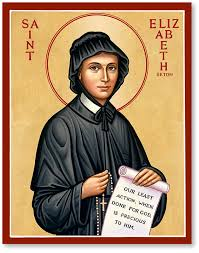
St. Elizabeth Ann Seton
1st born saint in America
Converted to the Catholic faith
Attempted to open schools to educate her 5 children
Founded the Sisters of Charity of St. Joseph
Opened schools and set the pattern for today’s parochial school system
At the invitation of Bishop Carroll, she opened a Catholic school for girls
Third Plenary Council of Baltimore; school
Pope Leo XIII called on Cardinal James Gibbons to lead the ______ ________ Council of ________.
Major decision from the Council → every Catholic parish should have its own ________. Met with great debate.
parochial; parish school
Poor immigrants raised money themselves to build parish, or __________, schools. The Council of Baltimore ruled that within 2 years every parish had to have a _____________.
excellence, faith;
Today, not all parishes have a parish school, but the Catholic school system is recognized for educational __________ and for its contribution in passing on the ________.
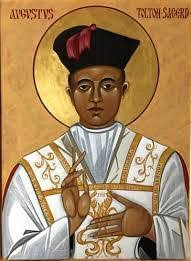
Augustus Tolton
1st African American priest ordained in the U.S.
Refused admission to any American seminary. He had to go to Rome for this training.
Ministered in Illinois.
His attempt to organize a black parish there met with resistance from white Catholics and Protestants.
After reassignment to Chicago, he led the development and administration of the black “national parish” of St. Monica’s.
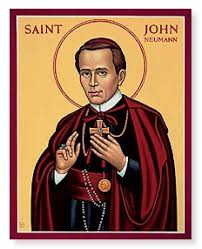
St. John Neumann
Redemptorist
4th bishop of Philadelphia
1st U.S. bishop to organize a Diocesan Catholic school system
Worked among German immigrants with other immigrant communities because of his knack for languages
1st U.S. bishop to be canonized
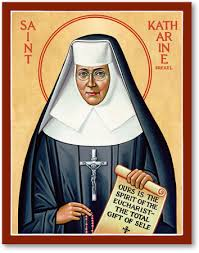
St. Katharine Drexel
Wealthy
Established the Sisters of the Blessed Sacrament
Dedicated her large inheritance to the care of Native Americans and African Americans
Founded more than 60 missions around the U.S.
Founded Xavier University in Louisiana, a Catholic university with a particular mission to serve African American students. (only Catholic HBCU in the U.S)
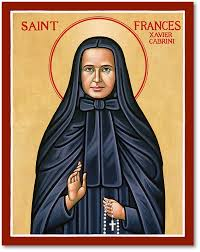
St. Frances Xavier Cabrini
Italian woman who founded the Missionary Sisters of the Sacred Heart in Italy
At the urging of Pope Leo XIII, she came to New York with 6 sisters from her community to work among the italian immigrants
Established orphanages, schools, and hospitals
Baltimore Catechism
Featured a question-and-answer format (with 499 total questions covered). Was used in Catholic schools and institutions until the 2nd Vatican Council.
Catholicism, America; Georgetown; 240
Bishop John Carroll placed a high value on education, which he believed to be essential to securing the continuation of the Church’s ministry and adaptations of ___________ to ___________ ideals.
He dreamed of a national Catholic college and drew up plans for an academy in ___________.
Since the opening of Georgetown, more than _____ Catholic colleges and universities have been established in the U.S.
John Hughes
Bishop of New York
worked hard to overcome anti-Catholic feelings
Responsible for the building of St. Patrick’s Cathedral
Cathedral was a strong stand against the violence towards immigrants
John McCloskey
bishop of New York
1st U.S. priest named a cardinal
3
How many popes from Africa have there been?